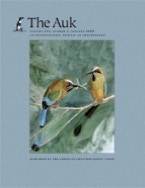
Publications
* indicates student author


van der Velde, M., Borger M. J.*, Johnson L. E.*, Murphy T. G.^, Komdeur J.^ (2022) No genetic evidence for parent-offspring relatedness in post-breeding social groups of Black-crested Titmouse (Baelophus atricristatus). The Wilson Journal of Ornithology. PDF ^shared last authorship
Borger M. J.*, Johnson L. E.*, Salazar N. O.*, Dreghorn C. L.*, Komdeur J.^, Murphy T. G.^ (2020) The influence of social-grouping on territorial defense behavior in the black-crested titmouse (Baeolophus atricristatus). Behavioral Ecology and Sociobiology 74:141. PDF ^authors contributed equally
Kiere L. M.^*, Murphy T. G.^, García-Muñoz A.*, Osorio-Beristain, M. (2019) Ritualized display of a leaf: A putative agonistic signal in both sexes of a tropical bird. Behavioural Processes 168: 103954. PDF ^ authors contributed equally
Queller P. S.*, Murphy T. G. (2019) Painted Bunting (Passerina ciris) caught in the web of a giant lichen orb-weaver spider (Araneus bicentenarius). The Wilson Journal of Ornithology 131(1): 191–194, 2019. PDF
Queller P. S.*, Murphy T. G. (2017) Seasonal variation in the utility of a status signaling system: plumage ornament predicts foraging success only during periods of high competition. PLoS ONE 12: e0185584. PDF
Tarvin K. A., Wong L. J.*, Lumpkin C. D.*, Schroeder G. M.*, D’Andrea D.*, Meade S.*, Rivers P.*, Murphy T. G. (2016) Dynamic status signal reflects outcome of social interactions, but not energetic stress. Frontiers in Ecology and Evolution 4:79: 1-12. PDF
Simpson, R. K.*, Johnson, M. A., Murphy T. G. (2015) Migration and the evolution of sexual dichromatism: evolutionary loss of female coloration with migration among wood-warblers. Proceedings of the Royal Society, B 282: 20150375. PDF
Lumpkin D. C.*, Murphy T. G., Tarvin K. A. (2014) Blood parasite infection differentially relates to carotenoid-based plumage and bill color in the American goldfinch. Ecology and Evolution 4: 3210–3217. PDF
Murphy T. G., West J. A.*, Pham T. T.*, Cevallos L. M.*, Simpson, R. K.*, Tarvin K. A. (2014) Same trait, different receiver response: Unlike females, male American goldfinches do not signal status with bill colour. Animal Behaviour 93: 121-127. PDF
Pham T. T.*, Queller P. S.*, Tarvin, K. A., Murphy T. G. (2014) Honesty of a dynamic female aggressive status signal: baseline testosterone relates to bill color in female American goldfinches. Journal of Avian Biology 45: 22–28. PDF
Cook E. G.*, Murphy T. G., Johnson M. A. (2013) Colorful displays signal male quality in a tropical anole lizard. Naturwissenschaften 100: 993-996. PDF
Rosenthal M. F.*, Murphy T. G., Darling N., Tarvin K.A. (2012) Ornamental bill color rapidly signals changing condition. Journal of Avian Biology 43: 553–564. PDF
Tarvin K. A., Murphy T. G. (2012). It isn’t always sexy when both are bright and shiny: considering alternatives to sexual selection in elaborate monomorphic species. Ibis 154: 439-443. (invited commentary) PDF
Kelly R. J.*^, Murphy T. G.^, Tarvin K. A., and Burness G. (2012) Carotenoid-based ornaments of female and male American goldfinches (Spinus tristis) show sex-specific correlations with immune function and metabolic rate. Physiological and Biochemical Zoology 85: 348-363. ^ authors contributed equally PDF
Murphy T. G., Pham T. T.* (2012) Condition and brightness of structural blue-green: motmot tail-racket brightness is related to speed of feather growth in males, but not in females. Biological Journal of the Linnean Society 106: 673-681. PDF
Hall Z.*, MacDougall-Shackleton S.A., Osorio-Beristain M., Murphy T.G. (2010) Male bias in the song control system despite female bias in song rate in streak-backed orioles (Icterus pustulatus). Brain, Behavior and Evolution 76: 168-175. PDF
Murphy T. G., Rohwer V. G.*, Scholes E. (2010) Breeding biology and longevity of Russet-crowned Motmots in central Mexico. Journal of Field Ornithology 81: 13-16. PDF
Murphy T. G. (2010) Tail-racket removal increases hematocrit in male turquoise-browed motmots. Journal of Ornithology 151: 241-245. PDF
Murphy T. G., Rosenthal M. F. *, Montgomerie R., Tarvin K. A. (2009) Female American goldfinches use carotenoid-based bill coloration to signal status. Behavioral Ecology 20: 1348–1355. PDF
Murphy T. G., Hernández-Muciño D.*, Osorio-Beristain M., Montgomerie R., Omland K. E. (2009). Carotenoid-based status signaling by females in the tropical streak-backed oriole. Behavioral Ecology 20: 1000-1006. PDF
Price J.J., Yunes-Jiménez L.*, Osorio-Beristain M., Omland K. E., Murphy T. G. (2008) Sex-role reversal in song? Females sing more frequently than males in the streak-backed oriole. Condor 110: 387–392. PDF
Murphy T. G. (2008) Lack of assortative mating for tail, body size, or condition in the elaborate monomorphic Turquoise-browed Motmot (Eumomota superciliosa). Auk 125: 11–19. (cover article) PDF
Murphy T. G. (2008) Display of an inedible prop as a signal of aggression? Adaptive significance of leaf-display by the turquoise-browed motmot, Eumomota superciliosa. Ethology 114: 16-21. PDF


